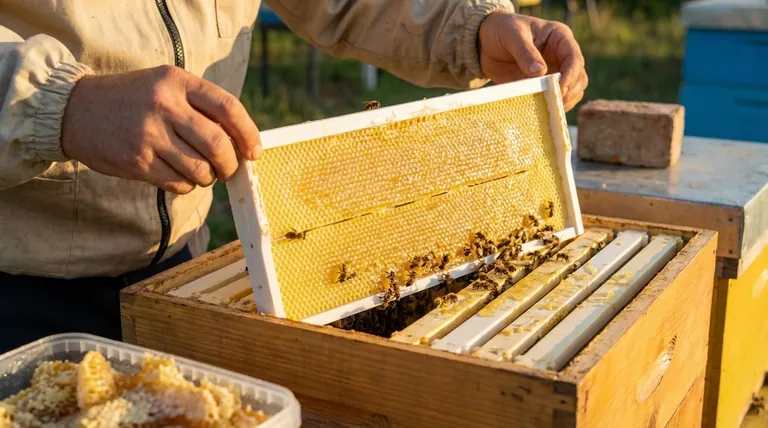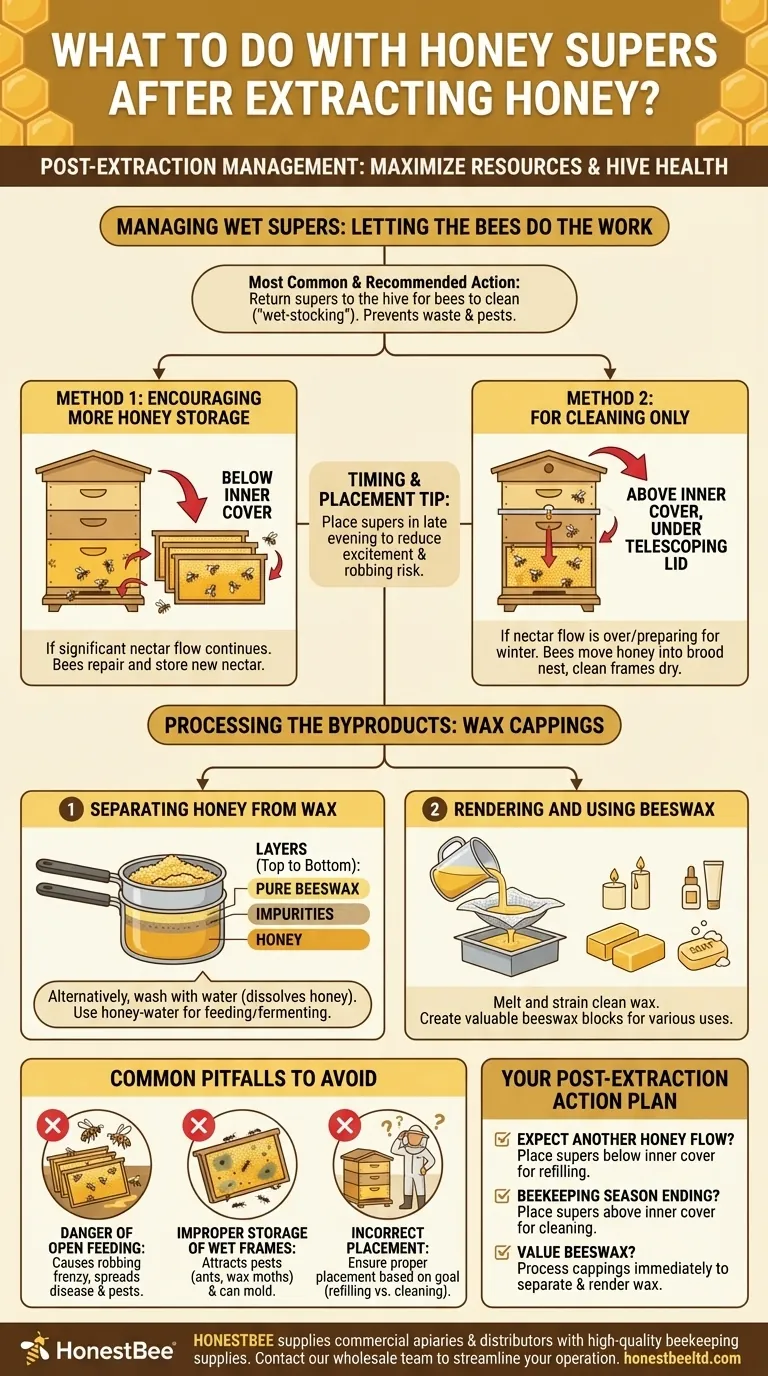The most common and recommended action is to return the honey supers to the hive for the bees to clean. This process, often called "wet-stocking," allows the bees to recover the residual honey, prevents waste, and prepares the frames for storage or immediate reuse. How you place them back on the hive depends entirely on whether you expect another honey flow.
Your primary goals after extraction are to prevent pests from being attracted to the sticky frames and to efficiently process the valuable byproducts. Letting your bees clean the supers is the most natural way to achieve the first goal, while rendering the wax cappings allows you to capitalize on the second.

Managing Wet Supers: Letting the Bees Do the Work
Your extracted frames, or "wet" supers, are covered in a thin layer of honey. This is a powerful attractant for pests and can lead to mold if stored improperly. Giving them back to the colony is the simplest and most beneficial solution.
Method 1: Encouraging More Honey Storage
If there is still a significant nectar flow in your area, you want the bees to refill the frames.
Place the supers directly back on the hive, just as they were before extraction—typically on top of the brood boxes but below the inner cover. This signals to the bees that these frames are part of the main hive, and they will quickly repair the cells and begin storing new nectar.
Method 2: For Cleaning Only
If the nectar flow is over and you're preparing for winter, your goal is simply to have the bees clean the frames.
Place the empty supers above the inner cover but under the main telescoping lid. The small hole in the inner cover allows the bees to access the supers. Because the frames are "outside" the main hive cavity, the bees' instinct is to move the resources (the honey) down into the main brood nest for safekeeping, effectively cleaning the frames dry within a few days.
Processing the Byproducts: Wax Cappings
The wax cappings you sliced off the frames are a valuable mixture of pure beeswax and a significant amount of honey. You must process them to separate these two resources.
Separating Honey from Wax
The first step is to get the honey out of the cappings. You can do this by washing the cappings in cold or lukewarm water. This dissolves the honey, leaving you with clean wax and a sweet honey-water mixture that can be used for feeding bees (with caution) or fermenting.
Alternatively, you can use heat. Gently melting the cappings in a double boiler will cause the mixture to separate into three distinct layers as it cools. The heavy honey will sink to the bottom, the pure beeswax will float and harden on top, and a layer of impurities will form in the middle.
Rendering and Using Beeswax
Once the wax is separated and clean, you can melt it down completely. Strain it through cheesecloth to remove any final impurities.
Pour the clean, liquid wax into molds to create solid blocks of beeswax. This rendered wax is a valuable product that can be used for making candles, cosmetics, soaps, or for coating new hive equipment.
Common Pitfalls to Avoid
Properly managing wet supers is critical for hive health. A few common mistakes can create significant problems for your colonies.
The Danger of Open Feeding
Never leave wet supers out in the open for bees to clean. This can incite a "robbing frenzy," where bees from your hives and other nearby colonies aggressively fight over the resources.
This behavior leads to stressed, weakened colonies and is a primary way that diseases and pests, like varroa mites, are spread between hives.
Improper Storage of Wet Frames
Storing wet frames directly without cleaning is a mistake. The residual honey will attract pests like ants, wasps, and wax moths. It can also ferment and grow mold, ruining your drawn comb, which is an incredibly valuable resource.
Timing and Placement
When returning supers for cleaning, it's best to do it in the late evening. This reduces the initial excitement and minimizes the chance of robbing behavior from neighboring hives. Ensure the supers are placed correctly—either below the inner cover for refilling or above it for cleaning.
Your Post-Extraction Action Plan
Your choice depends on the time of year and your specific goals.
- If you expect another honey flow: Place the wet supers directly back on the hive below the inner cover so the bees can refill them.
- If the beekeeping season is ending: Place the supers above the inner cover to have the bees clean them out and move the remaining honey into their winter stores.
- If you value beeswax for other projects: Immediately begin processing your wax cappings to separate the honey and render the pure wax for future use.
By properly managing your supers and cappings, you conclude the harvest season efficiently while protecting your colony and preserving valuable resources for the year to come.
Summary Table:
| Post-Harvest Task | Primary Goal | Key Action |
|---|---|---|
| Managing Wet Supers | Prevent pests & clean frames | Return supers to the hive for bees to clean (wet-stocking). |
| Processing Wax Cappings | Separate honey & render beeswax | Melt and strain cappings to purify beeswax for various uses. |
| Avoiding Common Pitfalls | Maintain hive health | Never leave supers out in the open to prevent robbing and disease spread. |
Ready to streamline your beekeeping operation? Proper post-harvest management is key to a healthy, productive apiary. HONESTBEE supplies commercial apiaries and beekeeping equipment distributors with the durable, high-quality supplies needed for every step of the process, from extraction to storage. Let us help you protect your investment and maximize your yield. Contact our wholesale team today to discuss your equipment needs.
Visual Guide

Related Products
- Professional 500g Sectional Comb Honey Frame System for Beekeeping
- Langstroth Honey Bee Box Hive Boxes for Different Depths
- Economy Small Scale Honey Dryer Dehumidifier Thickening Machine
- Professional Insulated Plastic Bee Hives
- Australian Langstroth Beehive Boxes for Beekeeping Wholesales
People Also Ask
- How long does it take for bees to fill a frame with honey? It Depends on These 4 Key Factors
- How much honey can you get from one frame? Maximize Your Harvest with the Right Frame Size
- Why might a customer look for shallow equipment in a store? To Reduce Weight and Enhance Hive Management
- What frame to use for honeycomb? Choose the Right System for Pure, Edible Comb
- How do bees use Flow Frames? A Guide to Stress-Free Honey Harvesting



















